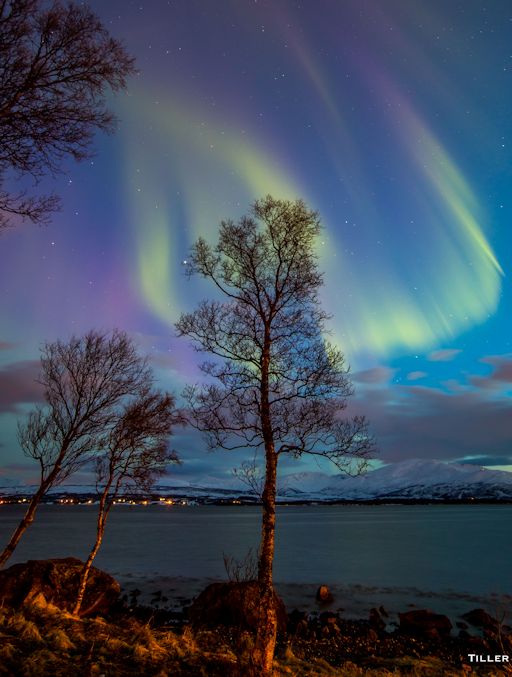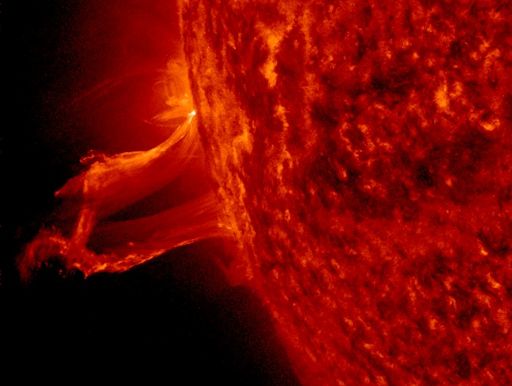Learn to photograph Northern Lights like a pro. Sign up for Peter Rosen's Aurora Photo Courses in Abisko National Park. | | | GEOMAGNETIC STORM: A minor geomagnetic storm is underway as Earth enters a hgh-speed stream of solar wind. Forecasters espect these storm continues to continue through April 16th. High-latitude sky watchers should be alert for auroras. Aurora alerts: text, voice TWILIGHT AURORAS: Around the Arctic Circle, night is vanishing as the summer sun rises over the polar realm. This is creating a short-lived mixture of colors in the sky: aurora green and twilight blue. Truls Tiller sends this picture of the phenomenon from Tromsø City, Norway: 
"On April 15th, the 'night' sky was almost daylight, but the auroras were visible anyway," says Tiller. "These could be the last aurora photos from Tromsø until autumn, because of the light and the sun, but we will be back." Actually, they are probably the second-to-last. The ongoing geomagnetic storm could add one more dash of green to the twilight before the Arctic sun finally overwhelms the Northern Lights. Monitor the aurora gallery for last-chance sightings. Realtime Aurora Photo Gallery EXTRAORDINARY STRETCH: On April 14th, an unstable filament of magnetism rose up and erupted from the sun's eastern limb. This image from NASA's Solar Dynamics Observatory shows the first moments of a very high-rising prominence: 
The magnetic loop shown above quickly exited SDO's field of view. It kept going ... and going... until it stretched itself out almost 700,000 km long. In East Devon, UK, amateur astronomer David Strange was monitoring the sun and witnessed the extraordinary stretch through the eyepiece of a backyard solar telecope. French astrophotographer Sylvain Weiller saw it, too. For comparison, the prominence was half the diameter of the sun and twice as long as the distance between Earth and the Moon. "It went to an unbelievable height," says Weiller. Part of the prominence snapped off and formed the core of a bright CME: movie. The expanding cloud billowed away from the sun's eastern limb, well off the sun-Earth line, and is not expected to hit our planet. Solar flare alerts: text, voice Realtime Space Weather Photo Gallery
Realtime Eclipse Photo Gallery
Realtime Comet Photo Gallery
Every night, a network of NASA all-sky cameras scans the skies above the United States for meteoritic fireballs. Automated software maintained by NASA's Meteoroid Environment Office calculates their orbits, velocity, penetration depth in Earth's atmosphere and many other characteristics. Daily results are presented here on Spaceweather.com. On Apr. 15, 2015, the network reported 18 fireballs.
(18 sporadics)  In this diagram of the inner solar system, all of the fireball orbits intersect at a single point--Earth. The orbits are color-coded by velocity, from slow (red) to fast (blue). [Larger image] [movies] Potentially Hazardous Asteroids ( PHAs) are space rocks larger than approximately 100m that can come closer to Earth than 0.05 AU. None of the known PHAs is on a collision course with our planet, although astronomers are finding new ones all the time. On April 15, 2015 there were potentially hazardous asteroids. Notes: LD means "Lunar Distance." 1 LD = 384,401 km, the distance between Earth and the Moon. 1 LD also equals 0.00256 AU. MAG is the visual magnitude of the asteroid on the date of closest approach. | | The official U.S. government space weather bureau | | | The first place to look for information about sundogs, pillars, rainbows and related phenomena. | | | Researchers call it a "Hubble for the sun." SDO is the most advanced solar observatory ever. | | | 3D views of the sun from NASA's Solar and Terrestrial Relations Observatory | | | Realtime and archival images of the Sun from SOHO. | | | from the NOAA Space Environment Center | | | the underlying science of space weather | | 
